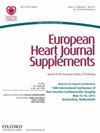Unlocking the enigma: decoding premature ventricular complexes for effective clinical assessment and risk management
IF 1.7
4区 医学
Q3 CARDIAC & CARDIOVASCULAR SYSTEMS
引用次数: 0
Abstract
The identification of ventricular premature complexes during a cardiological evaluation necessitates the implementation of diagnostic processes aimed at discerning the clinical context that may predispose individuals to a high risk of sudden cardiac death. Epidemiological studies reveal that ventricular premature beats occur in approximately 75% of healthy (or seemingly healthy) individuals, as long as there is no evidence of underlying structural heart disease, such as benign idiopathic ventricular extrasystole originating from the right and left ventricular outflow tracts. In the real world, however, ventricular ectopic beats with morphologies very similar to seemingly benign occurrences are not uncommon. They are notable in subjects exhibiting rapid and complex repetitive forms during exercise testing and Holter electrocardiogram. Additionally, these subjects may display more or less extensive scarring signs on cardiac magnetic resonance and may have a family history of cardiomyopathy and/or sudden cardiac death. Therefore, the purpose of this review is to critically analyse the process of evaluating premature ventricular complexes, which is crucial for accurate risk stratification. The latter cannot overlook some inevitable elements, including morphology, origin, complexity, and the associated clinical setting (absence or presence of structural heart disease).揭开谜底:解码室性早搏,实现有效的临床评估和风险管理
在心脏评估过程中发现室性早搏复律时,有必要实施诊断程序,以辨别可能导致心脏性猝死高风险的临床背景。流行病学研究表明,只要没有潜在结构性心脏病的证据,如源于左右心室流出道的良性特发性室性期外收缩,约 75% 的健康人(或看似健康的人)都会出现室性早搏。然而,在现实生活中,形态与看似良性的心室异位搏动非常相似的情况并不少见。在运动测试和 Holter 心电图中表现出快速和复杂的重复形式的受试者中,异位搏动尤为明显。此外,这些受试者可能在心脏磁共振上显示或多或少的广泛瘢痕征象,并可能有心肌病和/或心脏性猝死的家族史。因此,本综述旨在批判性地分析室性早搏复律的评估过程,这对准确的风险分层至关重要。后者不能忽略一些不可避免的因素,包括形态、起源、复杂性和相关的临床环境(是否存在结构性心脏病)。
本文章由计算机程序翻译,如有差异,请以英文原文为准。
求助全文
约1分钟内获得全文
求助全文
来源期刊

European Heart Journal Supplements
医学-心血管系统
CiteScore
3.00
自引率
0.00%
发文量
575
审稿时长
12 months
期刊介绍:
The European Heart Journal Supplements (EHJs) is a long standing member of the ESC Journal Family that serves as a publication medium for supplemental issues of the flagship European Heart Journal. Traditionally EHJs published a broad range of articles from symposia to special issues on specific topics of interest.
The Editor-in-Chief, Professor Roberto Ferrari, together with his team of eminent Associate Editors: Professor Francisco Fernández-Avilés, Professors Jeroen Bax, Michael Böhm, Frank Ruschitzka, and Thomas Lüscher from the European Heart Journal, has implemented a change of focus for the journal. This entirely refreshed version of the European Heart Journal Supplements now bears the subtitle the Heart of the Matter to give recognition to the focus the journal now has.
The EHJs – the Heart of the Matter intends to offer a dedicated, scientific space for the ESC, Institutions, National and Affiliate Societies, Associations, Working Groups and Councils to disseminate their important successes globally.
 求助内容:
求助内容: 应助结果提醒方式:
应助结果提醒方式:


